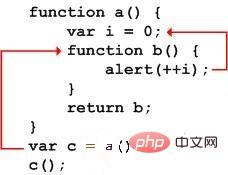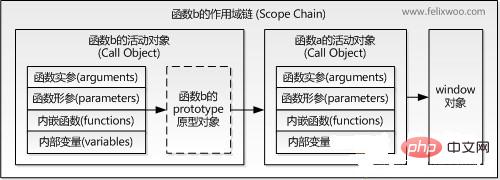Home > Article > Web Front-end > Detailed explanation of the concept of closure in JS (with examples)
Closure (closure) is a difficulty and characteristic of the Javascript language. Many advanced applications rely on closures.
1. The scope of variables
To understand closures, you must first understand the special variable scope of Javascript.
The scope of variables is nothing more than two types: global variables and local variables.
The special thing about the Javascript language is that global variables can be read directly inside the function.
var n=999;
function f1(){
alert(n);
}
f1(); // 999On the other hand, local variables within the function cannot be read outside the function.
function f1(){
var n=999;
}
alert(n); // errorThere is one thing to note here. When declaring variables inside a function, you must use the var command. If you don't use it, you are actually declaring a global variable!
function f1(){
n=999;
}
f1();
alert(n); // 9992. How to read local variables from the outside
For various reasons, we sometimes need to get local variables within a function. However, as mentioned before, this is not possible under normal circumstances and can only be achieved through workarounds.
That is to define another function inside the function.
function f1(){
n=999;
function f2(){
alert(n); // 999
}
}
In the above code, function f2 is included inside function f1. At this time, all local variables inside f1 are visible to f2. But the reverse doesn't work. The local variables inside f2 are invisible to f1. This is the unique "chain scope" structure of the Javascript language.
The child object will search for the variables of all parent objects level by level. Therefore, all variables of the parent object are visible to the child object, but not vice versa.
Since f2 can read the local variables in f1, then as long as f2 is used as the return value, can't we read its internal variables outside f1?
function f1(){
n=999;
function f2(){
alert(n);
}
return f2;
}
var result=f1();
result(); // 9993. The concept of closure
The f2 function in the code in the previous section is a closure.
The definition of "closure" in various professional literature is very abstract and difficult to understand. My understanding is that a closure is a function that can read the internal variables of other functions.
Since in the Javascript language, only sub-functions inside the function can read local variables, closures can be simply understood as "functions defined inside a function".
So, in essence, closure is a bridge connecting the inside of the function with the outside of the function.
4. The use of closures
Closures can be used in many places. It has two greatest uses. One is to read the variables inside the function as mentioned earlier, and the other is to keep the values of these variables in memory.
How to understand this sentence? Please look at the code below.
function f1(){
var n=999;
nAdd=function(){n+=1}
function f2(){
alert(n);
}
return f2;
}
var result=f1();
result(); // 999
nAdd();
result(); // 1000In this code, result is actually the closure f2 function. It was run twice, the first time the value was 999, the second time the value was 1000. This proves that the local variable n in function f1 is always stored in memory and is not automatically cleared after f1 is called.
Why is this so? The reason is that f1 is the parent function of f2, and f2 is assigned to a global variable, which causes f2 to always be in memory, and the existence of f2 depends on f1, so f1 is always in memory and will not be deleted after the call is completed. , recycled by the garbage collection mechanism (garbage collection).
Another thing worth noting in this code is the line "nAdd=function(){n =1}". First of all, the var keyword is not used before nAdd, so nAdd is a global variable. rather than local variables. Secondly, the value of nAdd is an anonymous function, and this
anonymous function itself is also a closure, so nAdd is equivalent to a setter, which can operate on local variables inside the function outside the function.
5. Points of note when using closures
1) Since closures cause all variables in the function to be stored in memory, memory consumption is very high. Large, so closures cannot be abused, otherwise it will cause performance problems on the web page, and may cause memory leaks in IE. The solution is to delete all unused local variables before exiting the function.
2) The closure will change the value of the variable inside the parent function outside the parent function. Therefore, if you use the parent function as an object, the closure as its public method, and the internal variables as its private value, you must be careful not to Feel free to change the value of the variable inside the parent function.
6. Thinking questions
If you can understand the results of the following code, you should understand the operating mechanism of closure.
var name = "The Window";
var object = {
name : "My Object",
getNameFunc : function(){
return function(){
return this.name;
};
}
};
alert(object.getNameFunc()());//The WindowJS closure example:
function outerFun()
{
var a=0;
function innerFun()
{
a++;
alert(a);
}
}
innerFun()The above code is wrong. The scope of innerFun() is inside outerFun(), and it is wrong to call it outside outerFun().
Change to the following, which is a closure:
function outerFun()
{
var a=0;
function innerFun()
{
a++;
alert(a);
}
return innerFun; //注意这里
}
var obj=outerFun();
obj(); //结果为1
obj(); //结果为2
var obj2=outerFun();
obj2(); //结果为1
obj2(); //结果为2What is a closure:
When an internal function is referenced outside the scope in which it is defined, it is created For the closure of the inner function, if the inner function refers to variables located in the outer function, these variables will not be released in memory after the outer function is called, because the closure requires them.
Example:
function outerFun()
{
var a =0;
alert(a);
}
var a=4;
outerFun();
alert(a);The result is 0,4. Because the var keyword is used inside the function to maintain the scope of a inside outFun().
Look at the following code again:
function outerFun()
{
//没有var
a =0;
alert(a);
}
var a=4;
outerFun();
alert(a); The result is 0,0 which is really strange, why?
作用域链是描述一种路径的术语,沿着该路径可以确定变量的值 .当执行a=0时,因为没有使用var关键字,因此赋值操作会沿着作用域链到var a=4; 并改变其值.
如果你对javascript闭包还不是很理解,那么请看下面转载的文章:
一、什么是闭包?
官方”的解释是:闭包是一个拥有许多变量和绑定了这些变量的环境的表达式(通常是一个函数),因而这些变量也是该表达式的一部分。
相信很少有人能直接看懂这句话,因为他描述的太学术。其实这句话通俗的来说就是:JavaScript中所有的function都是一个闭包。不过一般来说,嵌套的function所产生的闭包更为强大,也是大部分时候我们所谓的“闭包”。看下面这段代码:
function a() {
var i = 0;
function b() { alert(++i); }
return b;
}
var c = a();
c();这段代码有两个特点:
1、函数b嵌套在函数a内部;
2、函数a返回函数b。
引用关系如图:

这样在执行完var c=a()后,变量c实际上是指向了函数b,再执行c()后就会弹出一个窗口显示i的值(第一次为1)。这段代码其实就创建了一个闭包,为什么?因为函数a外的变量c引用了函数a内的函数b,就是说:
当函数a的内部函数b被函数a外的一个变量引用的时候,就创建了一个闭包。
让我们说的更透彻一些。所谓“闭包”,就是在构造函数体内定义另外的函数作为目标对象的方法函数,而这个对象的方法函数反过来引用外层函数体中的临时变量。这使得只要目标 对象在生存期内始终能保持其方法,就能间接保持原构造函数体当时用到的临时变量值。尽管最开始的构造函数调用已经结束,临时变量的名称也都消失了,但在目 标对象的方法内却始终能引用到该变量的值,而且该值只能通这种方法来访问。即使再次调用相同的构造函数,但只会生成新对象和方法,新的临时变量只是对应新 的值,和上次那次调用的是各自独立的。
二、闭包有什么作用?
简而言之,闭包的作用就是在a执行完并返回后,闭包使得Javascript的垃圾回收机制GC不会收回a所占用的资源,因为a的内部函数b的执行需要依赖a中的变量。这是对闭包作用的非常直白的描述,不专业也不严谨,但大概意思就是这样,理解闭包需要循序渐进的过程。
在上面的例子中,由于闭包的存在使得函数a返回后,a中的i始终存在,这样每次执行c(),i都是自加1后alert出i的值。
那 么我们来想象另一种情况,如果a返回的不是函数b,情况就完全不同了。因为a执行完后,b没有被返回给a的外界,只是被a所引用,而此时a也只会被b引 用,因此函数a和b互相引用但又不被外界打扰(被外界引用),函数a和b就会被GC回收。(关于Javascript的垃圾回收机制将在后面详细介绍)
三、闭包内的微观世界
如果要更加深入的了解闭包以及函数a和嵌套函数b的关系,我们需要引入另外几个概念:函数的执行环境(excution context)、活动对象(call object)、作用域(scope)、作用域链(scope chain)。以函数a从定义到执行的过程为例阐述这几个概念。
当定义函数a的时候,js解释器会将函数a的作用域链(scope chain)设置为定义a时a所在的“环境”,如果a是一个全局函数,则scope chain中只有window对象。当执行函数a的时候,a会进入相应的执行环境(excution context)。在创建执行环境的过程中,首先会为a添加一个scope属性,即a的作用域,其值就为第1步中的scope chain。即a.scope=a的作用域链。然后执行环境会创建一个活动对象(call object)。活动对象也是一个拥有属性的对象,但它不具有原型而且不能通过JavaScript代码直接访问。创建完活动对象后,把活动对象添加到a的作用域链的最顶端。此时a的作用域链包含了两个对象:a的活动对象和window对象。下一步是在活动对象上添加一个arguments属性,它保存着调用函数a时所传递的参数。最后把所有函数a的形参和内部的函数b的引用也添加到a的活动对象上。在这一步中,完成了函数b的的定义,因此如同第3步,函数b的作用域链被设置为b所被定义的环境,即a的作用域。
到此,整个函数a从定义到执行的步骤就完成了。此时a返回函数b的引用给c,又函数b的作用域链包含了对函数a的活动对象的引用,也就是说b可以访问到a中定义的所有变量和函数。函数b被c引用,函数b又依赖函数a,因此函数a在返回后不会被GC回收。
当函数b执行的时候亦会像以上步骤一样。因此,执行时b的作用域链包含了3个对象:b的活动对象、a的活动对象和window对象,如下图所示:

如图所示,当在函数b中访问一个变量的时候,搜索顺序是:
先搜索自身的活动对象,如果存在则返回,如果不存在将继续搜索函数a的活动对象,依次查找,直到找到为止。如果函数b存在prototype原型对象,则在查找完自身的活动对象后先查找自身的原型对象,再继续查找。这就是Javascript中的变量查找机制。如果整个作用域链上都无法找到,则返回undefined。
小结,本段中提到了两个重要的词语:函数的定义与执行。文中提到函数的作用域是在定义函数时候就已经确定,而不是在执行的时候确定(参看步骤1和3)。用一段代码来说明这个问题:
function f(x) {
var g = function () { return x; }
return g;
}
var h = f(1);
alert(h());这段代码中变量h指向了f中的那个匿名函数(由g返回)。
假设函数h的作用域是在执行alert(h())确定的,那么此时h的作用域链是:h的活动对象->alert的活动对象->window对象。假设函数h的作用域是在定义时确定的,就是说h指向的那个匿名函数在定义的时候就已经确定了作用域。那么在执行的时候,h的作用域链为:h的活动对象->f的活动对象->window对象。
如果第一种假设成立,那输出值就是undefined;如果第二种假设成立,输出值则为1。
运行结果证明了第2个假设是正确的,说明函数的作用域确实是在定义这个函数的时候就已经确定了。
四、闭包的应用场景
保护函数内的变量安全。以最开始的例子为例,函数a中i只有函数b才能访问,而无法通过其他途径访问到,因此保护了i的安全性。
在内存中维持一个变量。依然如前例,由于闭包,函数a中i的一直存在于内存中,因此每次执行c(),都会给i自加1。通过保护变量的安全实现JS私有属性和私有方法(不能被外部访问)
私有属性和方法在Constructor外是无法被访问的
function Constructor(...) {
var that = this;
var membername = value;
function membername(...) {...}
}以上3点是闭包最基本的应用场景,很多经典案例都源于此。
五、Javascript的垃圾回收机制
在Javascript中,如果一个对象不再被引用,那么这个对象就会被GC回收。如果两个对象互相引用,而不再被第3者所引用,那么这两个互相引用的对象也会被回收。因为函数a被b引用,b又被a外的c引用,这就是为什么函数a执行后不会被回收的原因
六、结语
理解JavaScript的闭包是迈向高级JS程序员的必经之路,理解了其解释和运行机制才能写出更为安全和优雅的代码。
想学习更多相关内容请访问PHP中文网:javascript视频教程
The above is the detailed content of Detailed explanation of the concept of closure in JS (with examples). For more information, please follow other related articles on the PHP Chinese website!